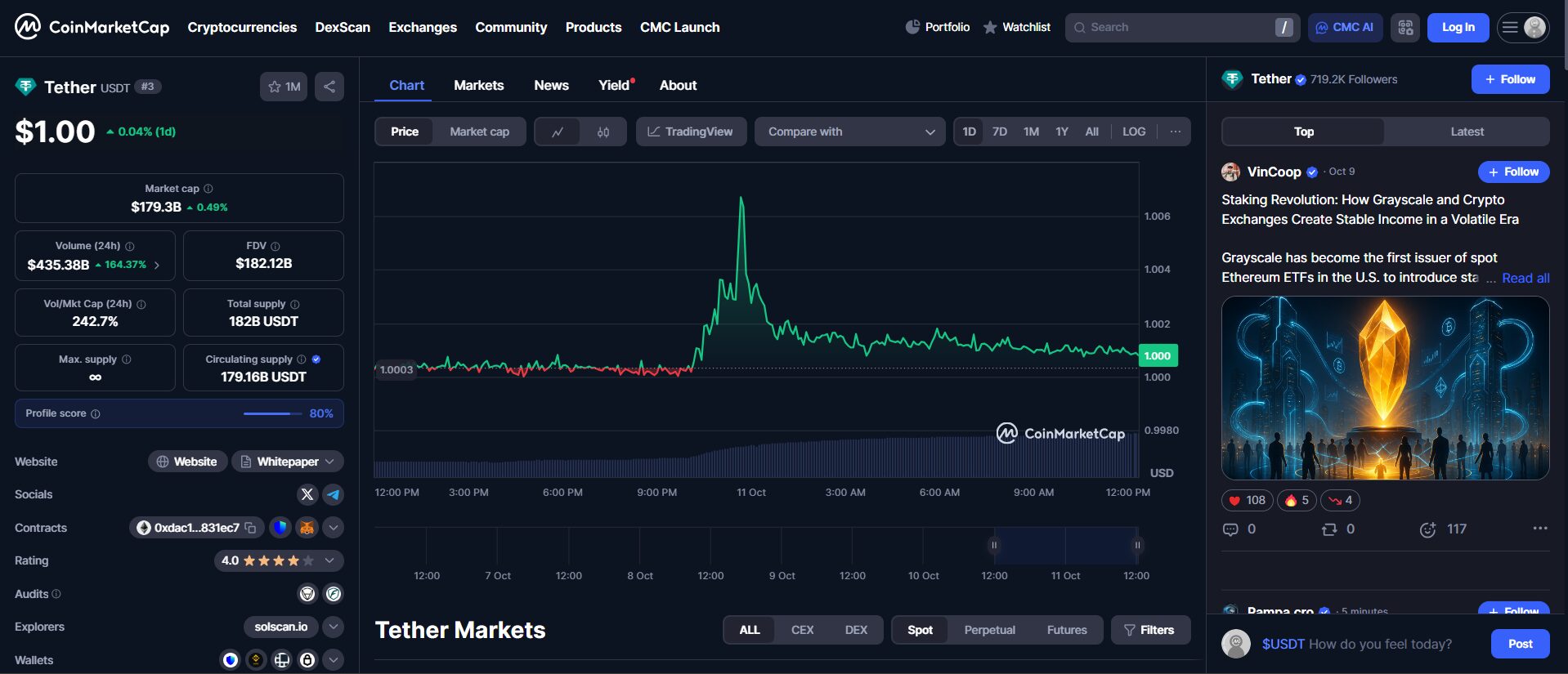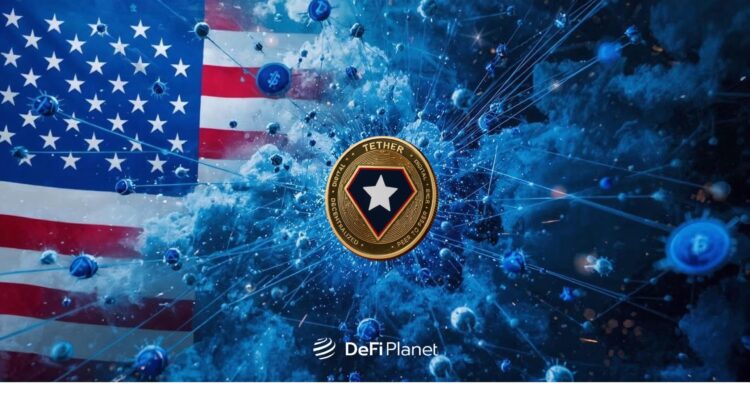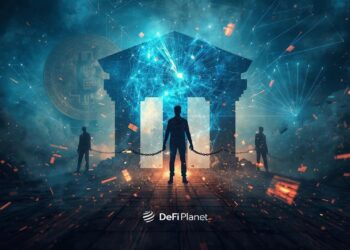Tether’s launch of the USAT stablecoin marks a turning point in the American decentralized finance (DeFi) scene. As DeFi continues to disrupt traditional finance by offering increased transparency, accessibility, and innovation, stablecoins remain the backbone of this ecosystem. These digital tokens, often pegged to the US dollar, provide the stability essential to seamless trading, lending, and borrowing within DeFi, without the wild price swings typical of other cryptocurrencies.
For years, Tether’s USDT has dominated this space, with billions moving daily across global platforms. But mounting U.S. regulatory pressure and growing demand for transparency prompted Tether, led by CEO Bo Hines, to introduce USAT, a fully U.S.-regulated stablecoin designed to bridge compliance with decentralization.
Background: Stablecoins as DeFi’s Foundation
The growth of DeFi is inextricably linked to the rise of stablecoins. These assets provide the necessary stability to facilitate financial activities within a volatile crypto environment. USDT, a pioneer in the stablecoin space, has been instrumental in this growth, serving as a primary medium of exchange across decentralized exchanges (DEXs) and lending platforms.
The regulatory environment in the U.S. has been a significant factor influencing stablecoin development. Lawmakers and financial authorities have expressed a desire for greater oversight to protect investors and prevent illicit activities.
This has led to the development of new frameworks, like the GENIUS Act, which establishes a federal structure for stablecoin issuers. In this context, USAT is designed to bridge the gap between the borderless nature of DeFi and America’s complex regulatory landscape. By launching a stablecoin that adheres to U.S. compliance standards, Tether is aiming to foster a more transparent and trustworthy ecosystem for American users and institutions.
Tether Unveils USA₮, its Planned U.S.-Regulated Dollar-Backed Stablecoin, and Will Appoint Bo Hines as CEO of Tether USA₮
Follow @USAT_io 🇺🇸https://t.co/w0JxBvttwv— Tether (@Tether_to) September 12, 2025
USAT’s Competitive Edge: A Threat to Circle’s USDC?
Tether’s launch of USAT, a fully U.S.-regulated stablecoin, positions it directly against Circle’s USDC, which has long been the go-to compliant stablecoin in America.
By leveraging partnerships with Anchorage and Cantor Fitzgerald, USAT enhances transparency, liquidity, and institutional trust. While USDC has an early-mover advantage and deep integration with U.S. financial systems, USAT’s dual strategy (USDT globally, USAT domestically) could disrupt Circle’s market share. The battle between the two may redefine the competitive landscape of stablecoins, DeFi adoption, and regulatory frameworks in the U.S.
USAT and USDT Co-existing
USAT is not intended to replace USDT but to function alongside it, specifically for the U.S. market’s unique regulatory and financial ecosystem. While USDT is used globally and largely without strict regulation, USAT will adhere to rigorous U.S. market standards. This includes institutional-grade oversight, partnerships with regulated custodians like Anchorage, and liquidity support from established financial firms such as Cantor Fitzgerald.
This dual-stablecoin approach allows Tether to maintain its global dominance with USDT while simultaneously satisfying the regulatory and custody requirements of U.S. investors and regulators with USAT. Early transactions involving USAT suggest a smooth launch and a strong potential for widespread DeFi adoption within the U.S..
This strategic differentiation addresses the evolving needs of the crypto market. The global crypto scene, with its diverse regulatory landscapes, can continue to use USDT, while U.S. institutions and individuals seeking a compliant, stable digital asset can turn to USAT. This two-pronged strategy demonstrates Tether’s adaptability and commitment to staying at the forefront of the stablecoin market.
Regulatory Frameworks: The GENIUS Act and USAT’s Compliance
US lawmakers have been working to strike a balance between innovation and financial stability. One of the most notable efforts is the proposed GENIUS Act (Guaranteeing Essential Nonbank Innovation and U.S. Stability Act). At its core, the Act seeks to bring order to the rapidly growing stablecoin and tokenized asset market by setting clear rules around reserve backing, redemption rights, and regular disclosures. Essentially, it aims to ensure that digital money functions with the same reliability and transparency expected of traditional financial products.
For USAT, this regulatory shift is more of an opportunity than a threat. Unlike many players that operate in gray zones, USAT has been building its framework with compliance in mind—embedding strict KYC/AML checks, publishing transparent reserve data, and aligning with capital standards that echo those in banking. This proactive stance does more than keep regulators at bay; it builds credibility with investors and institutions who are wary of unstable or poorly regulated tokens.
By anticipating the GENIUS Act’s requirements, USAT positions itself as a safer and more trustworthy option in a market often clouded by uncertainty. In doing so, it signals a larger truth: regulatory clarity is not the enemy of digital finance but the pathway to broader adoption. If the GENIUS Act sets the rules of the game, USAT is showing how to play by them—and win market trust in the process.
Benefits and Challenges for the DeFi Ecosystem
The introduction of USAT offers significant advantages for the American DeFi ecosystem. It can enhance trust and regulatory acceptance, potentially leading to broader institutional adoption and greater integration with traditional financial systems. USAT also aims to serve underbanked and under-financed communities by providing a stable, compliant digital dollar that can power DeFi applications from payments to lending. The partnership with Anchorage for custody and Cantor Fitzgerald for liquidity signals that a robust infrastructure is ready to support the demands for security and scalability.

However, challenges remain. The regulatory environment for stablecoins is still in flux, and achieving complete regulatory clarity is an ongoing process. The dual stablecoin model also requires user education and technical integration to ensure seamless interoperability across various DeFi platforms.
Despite these hurdles, USAT’s strategic partnerships with both crypto-native providers and traditional finance institutions signal a mature infrastructure prepared to meet the growing demand for compliant digital assets. It could become the premier U.S. stablecoin for everything from decentralized exchanges to corporate treasury management, driving innovation and growth in the local DeFi space.
The Broader Implications of USAT: Redefining DeFi in the U.S.
The emergence of the USAT marks a turning point for DeFi in the U.S., carrying implications that stretch far beyond the launch of another digital asset. At its heart, USAT represents an effort to fuse the innovation of blockchain with the credibility and safeguards of traditional finance—an intersection that has long been missing in the American DeFi landscape.
One of the most significant implications lies in legitimacy and trust. DeFi has often struggled with reputational risks tied to volatility, anonymous actors, and regulatory uncertainty. USAT’s compliance-first model, grounded in U.S. financial law, offers a counter-narrative: that DeFi protocols and tokenized assets can thrive within a regulated structure. This sets a precedent for other projects, signaling that regulation does not have to choke innovation but can serve as a framework for sustainable growth.
Another key impact is institutional adoption. Traditional financial institutions have been hesitant to engage with DeFi due to concerns over legal exposure and consumer protection. By adhering to strict reserve requirements, KYC/AML standards, and transparent reporting, USAT creates a product institutions can interact with confidently. This opens the door for deeper integration of blockchain-based assets into mainstream finance, from cross-border payments to tokenized securities.
On a broader scale, USAT has the potential to reshape competition in the stablecoin market, particularly against established players like Circle’s USDC and Tether’s USDT. Its compliance with U.S. laws positions it as a “homegrown” alternative, potentially favored by regulators and institutional players looking for safer, domestically anchored options. This could tilt the balance of power in a market currently dominated by offshore entities.
Beyond the financial system, the ripple effects of USAT extend to policy and innovation. If successful, it could serve as a proof of concept for lawmakers crafting future digital asset regulations, showing that a regulated DeFi ecosystem is not only possible but advantageous. At the same time, it encourages entrepreneurs to build products that align with regulatory expectations rather than sidestep them.
Ultimately, USAT redefines DeFi in the U.S. by moving it from the fringes of financial experimentation into the realm of structured innovation. By bridging compliance and decentralization, it may set the stage for a new era where DeFi is not an alternative to the financial system but a recognized extension of it.
Future Outlook: USAT and the Advancement of DeFi in the US
Tether’s USAT stablecoin could potentially balance the need for innovation with the realities of regulation. If compliant stablecoins like USAT gain traction, the industry could be poised for accelerated mainstream adoption. Tether is positioning itself not just as a market leader, but as an architect of the future American DeFi landscape, where transparency, compliance, and decentralization can coexist.
The coming years will show how effectively USAT integrates with a wide range of DeFi protocols and how it influences future regulatory policy. This new phase in American DeFi, driven by a stablecoin designed for compliance, will likely unlock opportunities for more users and institutions to participate in the ecosystem with greater confidence and security.
Disclaimer: This article is intended solely for informational purposes and should not be considered trading or investment advice. Nothing herein should be construed as financial, legal, or tax advice. Trading or investing in cryptocurrencies carries a considerable risk of financial loss. Always conduct due diligence.
If you would like to read more articles like this, visit DeFi Planet and follow us on Twitter, LinkedIn, Facebook, Instagram, and CoinMarketCap Community.
Take control of your crypto portfolio with MARKETS PRO, DeFi Planet’s suite of analytics tools.”





















